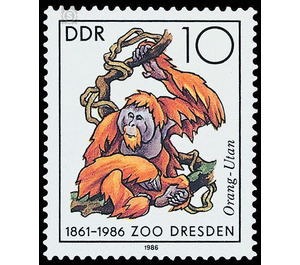125 years of dresden zoo - Germany / German Democratic Republic 1986 - 10 Pfennig
Theme: Animals
| Country | Germany / German Democratic Republic |
| Issue Date | 1986 |
| Face Value | 10.00 |
| Color | multi-colored |
| Perforation | K 14 |
| Printing Type | offset |
| Stamp Type | Postage stamp |
| Item Type | Stamp |
| Chronological Issue Number | 2761 |
| Chronological Chapter | GER-DDR |
| SID | 774527 |
| In 26 Wishlists | |
125th anniversary of ZOO Dresden On the occasion of the 125th anniversary of the zoological garden in Dresden, the Ministry of Posts and Telecommunications of the German Democratic Republic publishes four multi-colored special postage stamps. Special Cancellation from May 27 to July 26, 1986 125 Years of the Dresden Zoo Ever since the opening of the Dresden Zoo in 1861, monkeys have been introduced, and the first ape came to the zoo in 1873. Even today, this is the oldest zoological garden in the GDR as a "primate zoo", d. h. that in particular half-monkeys, animal monkeys and apes characterize its livestock. In the history of the Dresden zoo, two directors have made a name for themselves, especially through their publications on the orangutan biology. Gustav Brandes and Prof. Dr. med. Wolfgang Ullrich. It is thanks to their findings that today the breeding of these imposing apes, which are threatened with extinction in the wild, is no longer uncommon in many zoos. The zoological garden of Dresden has set itself the task to obtain by continuous breeding of several species of monkeys some representatives of the rare in the natural habitat of relatives of man to posterity. Four monkeys, which are exhibited in the Dresden Zoo and have already been bred, show the motifs of the present stamp series for the 125th anniversary of the zoo. Ten Penny Value: Orangutan (Pongo pygmaeus abeli) Two subspecies form these great apes designated as "forest people" (orangutans) by the South Asian islanders: Borneo orangutan as a nominate form, darkly colored and sturdier , and the Sumatran orangutans shown on the stamp, already bred in the second generation at the Dresden Zoo, as a light-colored subspecies. Asian apes live alone or in small family groups on the primeval forest giants of the tropical rainforest. They are excellently adapted in their biology to this biotope - fruits and leaves are the main food. They have Hangelarme, in order to be able to move comfortably in the branch. Sleeping nests and rain coverings are made by them and the young animals stay with their mother for a few years and thus get to know the orangutan life in good custody.


